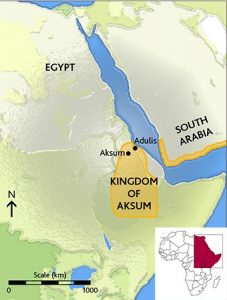The Kingdom of Aksum – One of the Four Greatest Powers of the Ancient World
 Aksum was the name of a city and a kingdom that extended over what today is known as Sudan, Egypt, Eritrea, Ethiopia, Djibouti, Somalia, Yemen and Saudi Arabia. It was one of the most powerful kingdoms of the ancient world. Aksum was a major naval and trading power from the 1st to the 7th centuries C.E. As a civilization it had a profound impact upon the people of Egypt, southern Arabia, Europe and Asia, all of whom were visitors to its shores, and in some cases were residents.
Aksum was the name of a city and a kingdom that extended over what today is known as Sudan, Egypt, Eritrea, Ethiopia, Djibouti, Somalia, Yemen and Saudi Arabia. It was one of the most powerful kingdoms of the ancient world. Aksum was a major naval and trading power from the 1st to the 7th centuries C.E. As a civilization it had a profound impact upon the people of Egypt, southern Arabia, Europe and Asia, all of whom were visitors to its shores, and in some cases were residents.
The Aksumites developed Africa’s only indigenous written script, Ge’ez.
The society had a hierarchical structure, ruled by a king at the top, followed by nobles and the general population below. In some descriptions, the ruler has been described as “King of Kings” which might suggest that there were other, junior kings in outlying parts of the empire which the Aksumites gradually took over.There is evidence of at least 10–12 small towns in the kingdom, which suggests it was an urban society.
Aksum embraced the Orthodox tradition of Christianity in the 4th century (c. 340–356 C.E.) under the rule of King Ezana. Prior to that, the people of Axum had practiced an indigenous polytheistic religion.
Nowadays, Aksum is famous for its obelisks.
More than 1000 obelisks had been discovered in and around Aksum, but roughly 300 are duly registered and documented. The biggest number of obelisks with a wide range of height, width and weight were found in today’s Aksum’s Northern Stelae Park, with the tallest and most emblematic stelae, the Obelisk of Aksum, rising nearly 25 meters high and weighing 170 tons.
In 1937, a tall stelae, broken into five parts and lying on the ground, was found by Italian soldiers in Aksum and shipped to be erected in Rome. This particular obelisk was widely regarded as one of the finest examples of engineering dating from the height of the Aksumite empire. Despite a 1947 United Nations agreement that the obelisk should be shipped back to Ethiopia, Italy refused to oblige and a long-standing diplomatic dispute between the two governments resulted. Finally, in April 2005, the obelisk returned to Ethiopia. UNESCO assumed the responsibility of re-installing the stelae, and by the end of July 2008, the obelisk rose again in all its enigmatic beauty in Aksum. Due to its most recent convulsive history it also became the symbol of national pride and identity.
Obelisks were the markings of tombs, at the same time representing the power and prestige of the deceased by the height, finishing and carvings of the stone. Only the obelisks of kings, besides being the tallest, were made of smoothly polished and decorated stone slabs. Nobles were buried under plain, but polished obelisks and the grave markings for ordinary folks were of roughly hewn stone. The individual slabs of the oldest pre-christian obelisks of kings were richly carved and decorated with geometric patterns and topped with a half moon. In order to assure the upright position of the tall obelisks they had cast metal discs affixed to their sides which were also carved with designs. Christian obelisks maintained the decorative tradition, but interpreted the half moon as ascent of the deceased to paradise.
